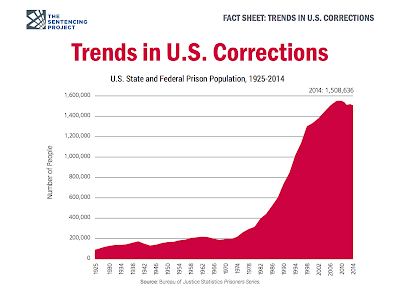Society in the 80s was a grim picture for African Americans
and people of colour and a narrative, which continues to be damaging to this
day, was constructed around race. When addressing racial matters in the 80s, it
is important to be aware of what came before and upon which ground Reagan was
building his domestic policies, for context is essential, particularly when addressing
race as a concern in American society.
Prior to the 1980s, presidents - such as Nixon - put in place a
variety of policies that partly nullified the victories that the Civil Rights
movement had won for racial equality in America. African Americans and people
of colour have lived in a society in which systems perpetually inhibit their
freedom and you can argue that these systems constantly change to remain
powerful; the 80s saw such a change.
Reagan’s ‘War on Drugs’ had many facets, but overall it
propelled a system of mass incarceration which sees vast numbers of citizens,
predominantly African Americans and people of colour, imprisoned for minor
offenses that constitute ridiculously inflated and disproportionate sentences.
This graph, for example, shows the hike in prison population under Reagan (1982-1990 in the case of this scale);
Crack cocaine was at the forefront of the War on Drugs and
it was essential in the process of criminalising African Americans and people
of colour throughout the 80s. In response to the Reagan Administration's
rhetoric regarding crack and its proliferation, Michelle Alexander suggests
that; Almost overnight, the media was saturated with images of black “crack
whores”, “crack dealers” and “crack babies” – images that seemed to confirm the
worst negative racial stereotypes about impoverished inner city residents (Alexander,
2012:5).
The coverage of the War on Drugs speaks to its legacy. It
began to criminalise African Americans and people of colour, not only in the
eyes of white Americans, but in the eyes of black communities to. ‘Super-Predator’
became a linguistic device amongst the media and even political leaders - Hilary Clinton
used the phase - to define this poor, normally non-white character in American
society.
Of course, such rhetoric is bound to breed a sense of fear
and anguish. In fact, during the Bush Snr. vs Dukakis campaign of 1988, the
notorious Willie Horton ad played on this exact construction of racial fear.
The use of Horton’s image was deliberately divisive in the way that it targeted
a scared, middle-class white demographic to garner political support. Jesse Jackson said on CBS News what few had
said publicly to that point: that using Horton’s case as a campaign message actually
played on racial fears (Sides, 2016).
There are similar
cases which suggest that this racial fear was prevalent in the police and
judiciary also. The central park jogger case, for example, saw five black youths criminalised
in the media and falsely imprisoned for attacking and raping a female jogger in
1989. Donald Trump actually took out a full page ad in numerous newspapers which
called for their execution by death penalty.
In terms of racial
identity, the 80s saw a worryingly visceral degradation of the image of African
Americans and people of colour across America. Politicians and the media played
on a societal fear that drew from racial stereotypes and destructive rhetoric surrounding
the War on Drugs. The criminalisation of African Americans and people of colour
caused a rift in society by terrifying white America and damaging black America's
sense of self. The portrayal of race during the 1980s is influential in terms
of the racial inequality that continues to plague America today.
2. Alexander, Michelle. The New Jim Crow: Mass Incarceration in the Age of Colourblindness. New York: The New Press, 2012










